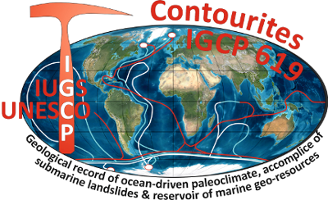Geological products: modern and ancient contourites
Leaders: D.A.V. Stow & J. Hernandez-Molina
The fundamental role of contourites and bottom currents in the construction and evolution of continental margins has been clearly documented. However, we need to greatly improve our understanding of the processes, products and controls involved. This will be achieved partly by establishing better diagnostic criteria for contourite identification, and partly through the application of new techniques. These include state-of-the-art geophysical techniques, manned submersibles and Remotely Operated Vehicles, sediment coring and scientific ocean drilling, and accompanying land investigations. The rapid proliferation of seismic geomorphology, 3-D seismic and AUV technology, sequence stratigraphy, and an increase in deep-water exploration by oil companies must be fully utilised. This objective has strong links to the IGCP Topic on Global Change.
Specific topics:
- Establishing depositional models for contourite depositional systems/contourite erosive features involving their initiation, processes, sediment facies, seismic facies and architectural elements; establishing also the gross sedimentary budgets.
- Understanding how bottom current and related physical processes cause contourite deposition and erosion, and how they lead to particular contourite facies, sequences and sedimentary structures (refining facies models).
- Determining the timing and extent of discontinuities and condensed sequences; the nature of corollary periods of along-slope deposition and drift development; and the means of paleodepth reconstructions.
- Elucidating the different orders and types of vertical contourite sequence, especially in seismic and high-resolution profiles, and their relation to global sea-level change; elucidating also how contourites fit in a sequence stratigraphic framework.
- Characterising the respective roles of sea-floor morphology, local topography, tectonic activity, sediment supply, climate change, oceanic gateways and sea-level controls on drift formation and erosion.
- Firmly establishing the outcrop-based recognition of ancient contourites with type localities for both carbonate and siliciclastic examples.



